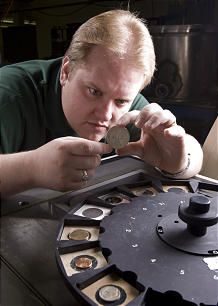New ways to detect a bogus coin
Aug 28th, 2007 by capitaladmin
BYU physics student Jeff Brown, who will graduate on Thursday, examines a coin… He says he has created four or five methods for unveiling counterfeits.
Although you may not have all the resources necessary to do this at home it will be a great resource in providing grading service companies to prove the authenticity of the coin you’re grading or insuring. Then again… you may not want to know that the coin you spent your month’s paycheck isn’t worth the plastic it’s been encapsulated in.
Crusty old gold miners in Hollywood Westerns bit into gold to see if they’d found the real thing, but biting down on a possibly rare gold coin is no way to determine if it is genuine or counterfeit. Gold is softer than teeth, so sinking incisors into the precious metal can reveal the real thing, but coins are generally harder and teeth marks damage their value.
The bite test also can deceive: Lead is even softer than gold.
One of the 2,372 Brigham Young University students graduating this week is wrapping up his senior thesis on new methods for testing coins purported to be rare finds. Jeff Brown, who is completing a bachelor’s degree in physics, used a specialized X-ray machine and an electron microscope to study about 50 coins.
“Back in the old days, people really would take a gold coin and bite it to see if it was real,” Brown said. “Now, with the added value these coins have accumulated, biting them ruins them.”
Using the X-ray spectrometer, Brown was able to plot a spectrum of materials in the coins. For example, he could determine how much silver and how much copper was in a purportedly valuable silver coin.
“We knew ahead of time which coins were counterfeit,” Brown said, “which aided in determining the counterfeit method.”
Brown said he created four or five methods for unveiling the fakes. They included using the electron microscope, which allowed him to take a close look at minute changes to mint marks.
“If it has a fake mint mark, I can spot it,” he said. “If it’s been sliced down the side and the silver has been taken out, I can spot it. If the normal wear and tear has been faked, I can spot it.”
In one case, an 1893 silver dollar worth $700 was altered to make it appear like it was a rarer variation worth $52,000. The less-valuable version was mass-produced without a mint mark. Only 100,000 of the rarer coins were made at the San Francisco mint, where they were stamped with a mint mark of S.
When Brown used the X-ray on a counterfeit coin, it determined the mint mark had the same elements of the rest of the coin. But under the microscope, Brown could see tool markings around the S, revealing that the metal had been heated and then a mound in the shape of an S had been raised to falsify its value.
Brown said the work is an example of the emphasis BYU has placed on mentored learning. The idea for the study belonged to his adviser, Lawrence Rees, who originally hoped to conduct the study himself using coins borrowed from an acquaintance. “I developed critical-thinking skills and problem-solving skills and how to use the equipment,” Brown said. “He was the real genius behind it, asking all the right questions and telling me when I’d gone wrong.” Rees has analyzed coins for the American Numismatic Association and is interested in the composition of older coins because the elements change over time.
While others have used microscopes and have studied the elements in coins, Rees believes Brown’s work could be the start of some interesting research. “He was able to establish some techniques useful in comparing the composition of silver and copper over time,” the professor said. “I think we can create an interesting timeline.” For example, Rees said, if a coin made in 1900 hadn’t lost copper, it would become immediately suspicious.
Brown is close to the typical BYU graduate in age, 25, turning 26 next month. The average grad in this August class, which will celebrate commencement exercises Thursday, is 25.6 years old. Brown spent two years at BYU-Idaho before transferring to Provo for his final three years. He initially planned to enter a graduate program at Idaho State University to study nuclear engineering but has deferred school for a year to take a job in Orem as a computer programmer.
[ via Deseret Morning News ]
